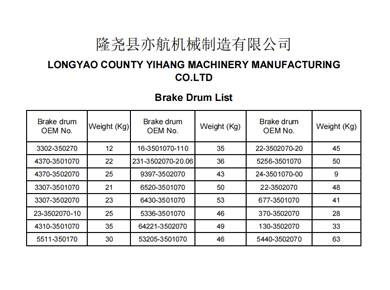Oct . 15, 2024 23:08 Back to list
Steps to Safely Disassemble and Remove a Rear Brake Drum from Your Vehicle
How to Remove a Rear Brake Drum A Step-by-Step Guide
Removing a rear brake drum may seem daunting, especially for those who are not mechanically inclined. However, with the right tools, a little patience, and a clear understanding of the process, you can accomplish this task with relative ease. Whether you need to replace worn-out brake shoes or inspect your brakes for maintenance, here is a step-by-step guide on how to remove a rear brake drum.
Tools You’ll Need
Before you begin, make sure you have the following tools on hand
1. Jack and Jack Stands – To lift the vehicle safely. 2. Lug Wrench – To remove the wheel nuts. 3. Drum Brake Tool Kit – This may include a brake spring tool, a flathead screwdriver, and a drum removal tool. 4. Hammer – Useful for gently tapping the brake drum if it's stuck. 5. Safety Goggles and Gloves – To protect yourself during the process.
Step 1 Prepare the Vehicle
1. Park on a Level Surface Ensure your vehicle is parked on a flat, stable surface to prevent it from rolling away. 2. Engage the Parking Brake This adds an extra layer of safety while you work. 3. Loosen Wheel Nuts Before raising the vehicle, use your lug wrench to loosen the wheel nuts slightly, but do not remove them entirely.
Step 2 Lift the Vehicle
1. Use the Jack Position your jack under the manufacturer’s recommended lift points (usually indicated in the owner's manual) and raise the vehicle off the ground. 2. Secure with Jack Stands Once the vehicle is lifted, place jack stands under the appropriate areas for additional safety. Never rely solely on the jack to hold the vehicle up.
Step 3 Remove the Wheel
1. Finish Removing the Wheel Nuts Now that the vehicle is securely elevated, remove the loosened wheel nuts completely. 2. Take Off the Wheel Carefully remove the wheel and set it aside.
Step 4 Inspect the Brake Drum
Before removing the brake drum, it’s essential to inspect the area. Look for any obvious signs of damage or wear, such as leaking brake fluid or worn components. If everything looks good, proceed to the next step.
Step 5 Remove the Brake Drum
how to remove rear brake drum

1. Check for Retaining Screws Some brake drums have screws that keep them in place. If you see any, use a screwdriver to remove them. 2. Tap the Drum If Necessary If the drum is stuck due to corrosion or dirt buildup, gently tap around the edges of the drum using a hammer. Be careful not to hit it too hard, as this could damage the drum. 3. Pull the Drum Off If the drum is free, it should slide off the hub. If it resists, continue gently tapping until it loosens.
Step 6 Inspect Brake Components
Once the drum is removed, take a moment to inspect the brake shoes, springs, and other components. Look for
- Excessive Wear If the brake shoes are worn down, they will need to be replaced. - Corrosion and Rust Check for any rust on the drum or hub that may need addressing. - Broken Springs If you see any broken or damaged springs, they will also need replacement.
Step 7 Clean Up
Before reassembling, clean the brake drum and surrounding components with brake cleaner. This helps remove dust, oil, and grime, ensuring all parts function correctly when reassembled.
Step 8 Reinstall or Replace
After conducting your inspections, you can choose to replace the brake shoes or reinstall the drum
1. If Replacing Brake Shoes Follow the manufacturer's instructions for installation. 2. Reinstall the Brake Drum If everything is in good condition, slide the drum back onto the hub.
Step 9 Reassemble the Wheel
1. Replace the Wheel Position the wheel back on the hub and hand-tighten the wheel nuts. 2. Lower the Vehicle Carefully remove the jack stands and lower the vehicle back to the ground. 3. Tighten the Wheel Nuts Use the lug wrench to securely tighten the wheel nuts in a crisscross pattern to ensure even pressure.
Final Thoughts
Once everything is back in place, take the vehicle for a short test drive to ensure the brakes are functioning correctly. Regular maintenance and inspections of your rear brake system can enhance safety and ensure optimal performance. With practice, removing and reassembling brake drums will become a routine task that keeps your vehicle running smoothly.
-
Scania Brake Drums: OEM Quality for Optimal Safety & Durability
NewsAug.16,2025
-
R.V.I: Advanced Remote Visual Inspection for Precision
NewsAug.15,2025
-
Discover HYUNDA: Innovative Vehicles, Equipment & Solutions
NewsAug.14,2025
-
R.V.I: Unlock Advanced Insights & Real-time Performance
NewsAug.13,2025
-
Kamaz Brake Drum: Durable & Reliable for Heavy Duty Trucks
NewsAug.12,2025
-
Heavy Duty Iveco Brake Drum - Premium Quality & Safety
NewsAug.11,2025
